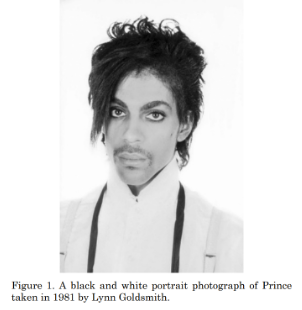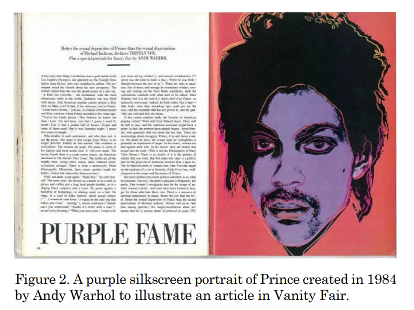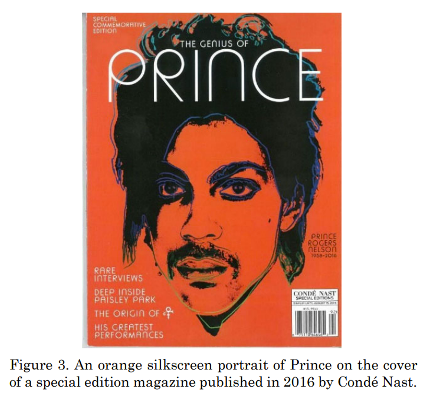On May 18, 2023, the U.S. Supreme Court issued its 43-page majority opinion in the case of Andy Warhol Foundation for the Visual Arts, Inc. v. Goldsmith, No. 21-869, 598 U.S. __ (May 18, 2023) (slip opinion linked here).
Facts. The facts of the case center around artistic creations of Andy Warhol and Lynn Goldsmith.
In the 1980s, Goldsmith, a photographer extraordinaire, captured images of many rock-n-roll stars, including Prince. In 1984, Goldsmith licensed to Vanity Fair magazine one of her photos of Prince for “one time” use as an “artist reference.” Vanity Fair wanted to use the photo for the creation of illustrations to be included in an article about Prince. Vanity Fair engaged renowned artist, Andy Warhol, to prepare the illustrations. Goldsmith was credited for the source and was paid $400. But, Warhol went on to create additional works using Goldsmith’s photo or the illustrations he created from it. In 2016, the Andy Warhol Foundation for the Visual Arts, Inc. (AWF) licensed one of those works to magazine publisher, Condé Nast, for illustrating another story about Prince. AWF received $10,000 for the license. Goldsmith received nothing.
Shown below are the three creative works in issue in the case:
Goldsmith, 598 U.S. __ (May 18, 2023) at pg. 4 (slip opinion)
Id. at pg. 5.
Id. at pg. 6.
Goldsmith informed AWF that the use of the photo in the Condé Nast magazine infringed her copyright in the photo she provided to Vanity Fair in 1984. In response, AWF sued her, claiming that AWF’s use was “fair use” and thus, pursuant to 17 U.S.C. § 107, was not an infringement on Goldsmith’s copyright. Goldsmith counterclaimed for infringement.
The federal district court in New York ruled in favor of AWF. The Court of Appeals for the Second Circuit reversed, finding that all factors of the fair use doctrine favored Goldsmith. AWF petitioned the matter to the U.S. Supreme Court, focusing primarily on the first factor of the fair use doctrine, being “the purpose and character of the use.” See 17 U.S.C. § 107(1). AWF contended that the purpose and character of its use of Goldsmith’s photograph weighed in favor of fair use because Warhol’s silkscreen image of the photograph has a new meaning or message than the original photograph created by Goldsmith, i.e., AWF claimed that its use was “transformative” and thus protected fair use.
Issue. Whether the fair use factor – “the purpose and character of the use, including whether such use is of a commercial nature or is for nonprofit educational purposes,” 17 U.S.C. § 107(1)—weighed in favor of AWF’s later commercial licensing.
Holding. No, AWF’s use of Goldsmith’s photograph was not fair use. Fair use, under section 107(1) of the Copyright Act, does not protect all use of a copyrighted work that might add some new expression, meaning, or message. Otherwise, “transformative use” would swallow the copyright owner’s exclusive right to prepare derivative works from an original. The Court stated as follows:
Although the purpose could be more specifically described as illustrating a magazine about Prince with a portrait of Prince, one that portrays Prince somewhat differently from Goldsmith’s photograph (yet has no critical bearing on her photograph), that degree of difference is not enough for the first factor to favor AWF, given the specific context of the use. To hold otherwise would potentially authorize a range of commercial copying of photographs, to be used for purposes that are substantially the same as those of the originals. As long as the user somehow portrays the subject of the photograph differently, he could make modest alterations to the original, sell it to an outlet to accompany a story about the subject, and claim transformative use. Many photographs will be open to various interpretations. A subject as open to interpretation as the human face, for example, reasonably can be perceived as conveying several possible meanings. The application of an artist’s characteristic style to bring out a particular meaning that was available in the photograph is less likely to constitute a “further purpose” as Campbell [v. Acuff-Rose Music, Inc., 510 U.S. 569 (1994)] used the term.
Goldsmith, 598 U.S. __ (May 18, 2023) at pg. 32 (slip opinion).
Key Points of Law.
Constitutional Authority for Copyright Protection. The U.S. Constitution empowers Congress to enact copyright laws “[t]o promote the Progress of Science and useful Arts.” U.S. Const. art. I, § 8, cl. 8. Congress has exercised this delegated authority continuously, beginning with the Copyright Act of 1790 and, more recently, through the Copyright Act of 1976. See Andy Warhol Foundation for the Visual Arts, Inc. v. Goldsmith, 11 F. 4th 26, 36 (2nd Cir. 2021), aff’d by Goldsmith, No. 21-869, 598 U.S. __ (May 18, 2023) (opinion of the Second Circuit linked here). Like other property rights, there is a “bundle of rights” associated with copyrights, including the right to reproduce a copyrighted work, to prepare derivative works, and, in the case of photographs or graphic works, to display the work publicly. Goldsmith, 598 U.S. __ (May 18, 2023) at pg. 13 (slip opinion).
Protection of Original Works and Derivative Works. Under the 1976 Act, copyright protection extends to the original creative work and to derivative works, which the Act defines as follows:
a work based upon one or more preexisting works, such as a translation, musical arrangement, dramatization, fictionalization, motion picture version, sound recording, art reproduction, abridgment, condensation, or any other form in which a work may be recast, transformed, or adapted. A work consisting of editorial revisions, annotations, elaborations, or other modifications which, as a whole, represent an original work of authorship, is a “derivative work”.
Exclusive Rights in Copyrighted Works. Section 106 of the Copyright Act provides as follows:
Subject to sections 107 through 122, the owner of copyright under this title has the exclusive rights to do and to authorize any of the following:
- to reproduce the copyrighted work in copies or phonorecords;
- to prepare derivative works based upon the copyrighted work;
- to distribute copies or phonorecords of the copyrighted work to the public by sale or other transfer of ownership, or by rental, lease, or lending;
- in the case of literary, musical, dramatic, and choreographic works, pantomimes, and motion pictures and other audiovisual works, to perform the copyrighted work publicly;
- in the case of literary, musical, dramatic, and choreographic works, pantomimes, and pictorial, graphic, or sculptural works, including the individual images of a motion picture or other audiovisual work, to display the copyrighted work publicly; and
- in the case of sound recordings, to perform the copyrighted work publicly by means of a digital audio transmission.
17 U.S.C. § 106(1)-(6) (emphasis added).
Rights of Authors to Attribution and Integrity. Section 106A of the Copyright Act provides that, subject to section 107 and independent of the exclusive rights provided in section 106, the author of a work of visual art shall have certain additional rights, such as to claim authorship and to prevent the use of the author’s name as the author of any work of visual art which the author did not create. 17 U.S.C. § 106A. Those authors also have the right to prevent the use of the author’s name as the author of the work of visual art in the event of a distortion, mutilation, or other modification of the work which would be prejudicial to the author’s honor or reputation. Authors within the meaning of section 106A may seek to prevent any intentional distortion, mutilation, or other modification of the particular work that may violate the rights vested in the author by section 106A. Id. at § 106A(a)-(a)(3)(B).
Limitation on Exclusive Rights: Fair Use, Section 107. Pursuant to the Copyright Act, the fair use of a copyright work is not an infringement of copyright. The fair use doctrine reflects a balance of competing claims upon the public interest—“‘Creative work is to be encouraged and rewarded, but private motivation must ultimately serve the cause of promoting broad public availability of literature, music, and the other arts.’” Goldsmith, 598 U.S. __ (May 18, 2023) at pg. 13 (slip opinion) (quoting Twentieth Century Music Corp. v. Aiken, 422 U.S. 151, 156 (1975)). Codified in 1976, the fair use statute provides as follows:
Notwithstanding the provisions of sections 106 and 106A, the fair use of a copyrighted work, including such use by reproduction in copies or phonorecords or by any other means specified by that section, for purposes such as criticism, comment, news reporting, teaching (including multiple copies for classroom use), scholarship, or research, is not an infringement of copyright. In determining whether the use made of a work in any particular case is a fair use the factors to be considered shall include—
-
- the purpose and character of the use, including whether such use is of a commercial nature or is for nonprofit educational purposes;
- the nature of the copyrighted work;
- the amount and substantiality of the portion used in relation to the copyrighted work as a whole; and
- the effect of the use upon the potential market for or value of the copyrighted work.
17 U.S.C. § 107(1).
The fair use provision of the Copyright Act calls for a holistic, context-sensitive inquiry “not to be simplified with bright-line rules[.] . . . All [four statutory factors] are to be explored, and the results weighed together, in light of the purposes of copyright.” Campbell v. Acuff-Rose Music, Inc., 510 U.S. 569, 577-78 (1994). The courts “apply [fair use] in light of the sometimes conflicting aims of copyright law,” and a copyright protection may be stronger where the work serves an artistic rather than a utilitarian function. Google LLC v. Oracle Am., Inc., __ U.S. __, 141 S. Ct. 1183, 1197, 209 L.Ed.2d 311 (2021).
Factor 1 – Purpose and Character. The first factor “focuses on whether an allegedly infringing use has a further purpose or different character, which is a matter of degree, and the degree of difference must be weighted against other considerations, like commercialism.” Goldsmith, 598 U.S. __ (May 18, 2023) at pg. 12 (slip opinion). The first factor considers the reasons for, and nature of, the copier’s use of an original work. The ‘central’ question it asks is ‘whether the new work merely ‘supersede[s] the objects’ of the original creation . . . (‘supplanting’ the original), or instead adds something new, with a further purpose or different character.’” Goldsmith, 598 U.S. __ (May 18, 2023) at pg. 15 (slip opinion) (quoting Campbell, 510 U.S. at 579).
Whether the purpose and character of a use weighs in favor of fair use is an objective inquiry into what use was made, i.e., what the user does with the original work.
Indeed, whether a work is transformative does not turn on the stated or perceived intent of the creator or the meaning or impression that a critic or judge draws from the work. The courts evaluate the degree to which the use is “transformative,” meaning “whether the new work merely supersedes the objects of the original creation, or instead adds something new, with a further purpose or different character, altering the first with new expression, meaning, or message.” Campbell, 510 U.S. at 579. Whether a work is “transformative” involves an evaluation of how the work may be “reasonably be perceived,” and examples of transformative uses include criticism, comment, news reporting, teaching, scholarship, and research. See 17 U.S.C. § 107. Another example is parody, which mimics an original work to make its point and is usually protected under the fair use doctrine.
Factor 1 – Commercial Use. The first factor in the fair use statute also directs courts to consider whether the use is of a commercial nature or is for nonprofit educational purposes. 17 U.S.C. § 107(1). Commercial use tends to weigh against finding that the use is “fair,” but that seemingly bright-line approach is applied with reluctance since essentially all uses of a work, even use by a nonprofit organization, are generally conducted for some type of monetary gain or exploitation. See Campbell, 510 U.S. at 584-85. The commercial nature of a secondary use is of decreased importance when the use is sufficiently transformative such that the primary author should not reasonably expect to be compensated.
Factor 2 – The Nature of the Copyrighted Work. This factor requires evaluation of (1) whether the work is expressive or creative or more factual, and (2) whether the work is published or unpublished, with the scope of fair use involving unpublished works being considerably narrower. See Goldsmith, 11 F. 4th at 45; Blanch v. Koons, 467 F.3d 244, 256 (2d Cir. 2006). That a creator might make a work available for a single use on limited terms does not change its status as an unpublished work nor diminish the law’s protection of the creator’s choice of when to make a work public and whether to withhold a work to shore up demand. Goldsmith, 11 F. 4th at 45.
Factor 3 – The Amount and Substantiality of the Use. This factor requires an evaluation of the quantity of the materials used as well as the quality and importance in relation to the original work. “The ultimate question under this factor is whether ‘the quantity and value of the materials used are reasonable in relation to the purpose of the copying.’” See Goldsmith, 11 F. 4th at 46 (quoting Campbell, 510 U.S. at 586). But, there is no bright line separating a permissible amount of borrowing from an impermissible one. See Google LLC, 593 U. S., at __ (slip op., at 24–25) (noting that “[a]n ‘artistic painting’ might, for example, fall within the scope of fair use even though it precisely replicates a copyrighted ‘advertising logo to make a comment about consumerism.’”); Rogers v. Koons, 960 F.2d 301, 309-11 (2d Cir. 1992) (noting that “Sometimes wholesale copying may be permitted, while in other cases taking even a small percentage of the original work has been held unfair use.”).
Factor 4 – The Effect of the Use on the Market for the Original. For this factor, the courts evaluate whether, if the challenged use becomes widespread, it will adversely affect the potential market for the copyrighted work. Thus, the courts consider the benefit the public will derive if the use is permitted and the personal gain the copyright owner will receive if the use is denied. This is a market-usurpation analysis that considers the primary market for the work and any derivative markets that exist or that its creator might reasonably license others to develop, regardless of whether the creator claiming infringement has elected to develop such markets. See Goldsmith, 11 F. 4th at 48.
Insights. The U.S. Supreme Court’s opinion in Goldsmith adds context to and consideration for the first factor of the Fair Use Doctrine. The holding could have a significant impact on the copyrights of artists, musicians, singers, photographers, and others whose works are used—fairly or unfairly—with or through artificial intelligence to create what are (or are arguably) derivative works that infringe on the creator’s rights. The boundaries of fair use remain extremely grey, and the case-by-case and context-sensitive evaluation lends itself to much subjective speculation about how a court of law, i.e., a judge or a panel of judges, may apply an objective analysis in determining whether a use of a copyrighted work is fair and thus non-infringing.
Fairly stated:
Not every instance will be clear cut, however. Whether a use shares the purpose or character of an original work, or instead has a further purpose or different character, is a matter of degree. Most copying has some further purpose, in the sense that copying is socially useful ex post. Many secondary works add something new. That alone does not render such uses fair. Rather, the first factor (which is just one factor in a larger analysis) asks “whether and to what extent” the use at issue has a purpose or character different from the original. The larger the difference, the more likely the first factor weighs in favor of fair use. The smaller the difference, the less likely.
Goldsmith, 598 U.S. __ (May 18, 2023) at pg. 15 (slip opinion) (internal citations omitted).



